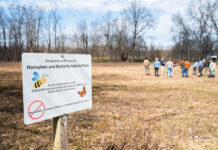SALEM, Ohio – Cows and farmers and researchers agree: Ensiling forages gets a lot more efficient and effective the faster it’s done.
Even with sunshine and temperature out of their hands, there remains one thing producers can do to speed silage-making and keep its end energy value at peak levels.
That solution is wide-swath management, a method researched and proven to work on New York farms.
The practice includes cutting forages into wider swaths to maximize drydown and yield, and minimize the time it takes to get the job done.
It’s cut and chopped and ensiled all in the same day, turning what is often days of work into just a day.
Not overlooked. Forages play an important role in dairy herd nutrition and have a place in beef herds, too, according to Tom Kilcer, a Cornell Cooperative Extension field crops specialist.
In their best and easiest use, forages are the backbone of rotational grazing programs, where cattle harvest the green crop and put it to use immediately.
In an economic analysis of nutrient sources, data showed forages cost less than grain as a source of protein and energy, Kilcer said.
But without careful management, silage can lose a tremendous amount of feed value as soon as it’s mowed.
Better product. “When we shorten the drying cycle by laying out wider swaths, we excel tremendously in silage quality,” Kilcer said.
That includes better overall quality and less dry matter loss.
By drying the forage crop faster, less respiration can take place. Respiration, the plant function in which the plant continues to use sugars, occurs from cutting until fermentation for silage or haylage, or proper drydown in the case of dry hay production.
Less sugar means less energy for the cow.
In addition, wider swath width exposes more plant leaves to sunlight, so photosynthesis can continue, Kilcer’s research shows. The energy produced by photosynthesis can typically keep pace with or exceed energy losses from respiration, he said.
Widened rows. He equates the idea to air-drying a pile of clothes: A pile that’s spread out will dry faster than a pile that’s heaped with less surface area to absorb sunlight and have air circulating around it.
It’s common sense, but not common practice when it comes to forage harvests.
Kilcer said many farmers he’s worked with during the project have 14-foot mowers that pile windrows just 3 feet wide.
He doesn’t push farmers to run out and buy the latest equipment, but instead to use what they’ve already got along with a healthy dose of thought and willingness to change.
“We’ve gone out there with a wrench and crawled around on the ground to get the mowers opened up. It’s amazing. Going to a 7-foot swath cut drying time in half,” Kilcer said.
The bad news is that’s still only half the mower’s potential. Kilcer said in order to be most effective, the swath needs to be at least 85 percent the width of the cutterbar.
Swath width is affected by removing or adjusting deflector shields on the mower.
Using a mower’s full capacity increases swath width 2.8 times, meaning moisture can be reduced from 85 percent to 60 percent in just a few hours.
It is acknowledged as a real lifesaver in the face of impending rain showers or other farm work that demands attention.
Potential. It’s also paying off in real-life examples.
In one study using alfalfa as the primary forage, 13 percent more milk was produced by cows fed a ton of first-cutting haylage chopped in wide swaths versus traditional narrow swaths.
That translates into 300 pounds more milk potential for every ton of silage produced.
One farm with yields of 3 tons per acre on 275 acres ‘earned’ an extra $33,000 in their milk check for the change.
“The bottom line is this will put more money back into your pocket,” Kilcer said.
Cautions. Kilcer points out leaving mowed forages lay in the field overnight is counter-productive, eliminating most of the energy in the dry matter saved by wide windrows.
A good rule of thumb for any silage harvest is to only mow what can be put into the silo the same day, he said.
(Reporter Andrea Myers welcomes reader feedback by phone at 1-800-837-3419 or by e-mail at amyers@farmanddairy.com.)
What’s the difference?
Silage: Fresh green forage that has been packed and fermented in a silo or bunker and stored there until it’s fed, little by little, to livestock. Fermentation is caused by enzymes in the plants and is aided by bacteria and yeast on the plants. Normal moisture content of silage is 65-70 percent.
Haylage: Low-moisture silage made up of grasses or legumes mowed and field-wilted to a lower moisture level than regular silage, usually around 40-60 percent.
Hay: The cut and dried stems and leaves of legumes and grasses used as livestock feed. Hay is dried to 20 percent moisture or less.
(Source: Texas A&M University and Minnesota Department of Agriculture)









